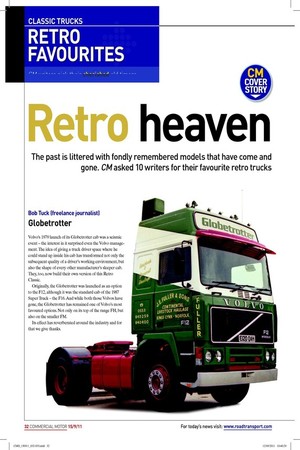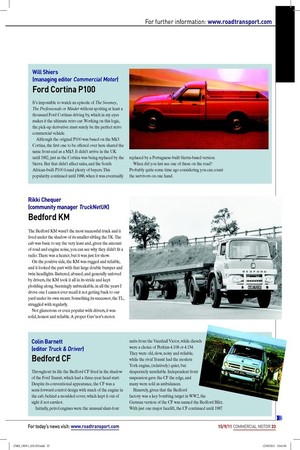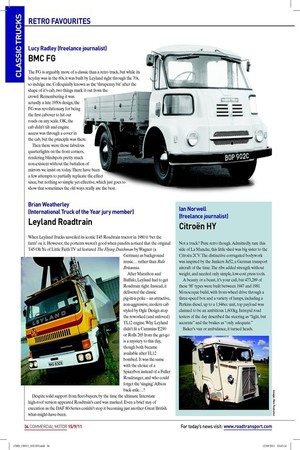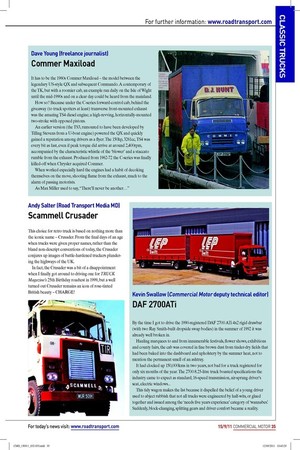etro heaven The past is littered with fondly remembered models
Page 26

Page 27

Page 28

Page 29

If you've noticed an error in this article please click here to report it so we can fix it.
that have come and gone. CM asked 10 writers for their favourite retro trucks
Bob Tuck (freelance journalist)
Globetrotter
Volvo’s 1979 launch of its Globetrotter cab was a seismic event – the interest in it surprised even the Volvo management. The idea of giving a truck driver space where he could stand up inside his cab has transformed not only the subsequent quality of a driver’s working environment, but also the shape of every other manufacturer’s sleeper cab. They, too, now build their own version of this Retro Classic.
Originally, the Globetrotter was launched as an option to the F12, although it was the standard cab of the 1987 Super Truck – the F16. And while both those Volvos have gone, the Globetrotter has remained one of Volvo’s most favoured options. Not only on its top of the range FH, but also on the smaller FM.
Its effect has reverberated around the industry and for that we give thanks.
Will Shiers (managing editor Commercial Motor)
Ford Cortina P100
It’s impossible to watch an episode of The Sweeney, The Professionals or Minder without spotting at least a thousand Ford Cortinas driving by, which in my eyes makes it the ultimate retro car. Working on this logic, the pick-up derivative must surely be the perfect retro commercial vehicle.
Although the original P100 was based on the Mk3 Cortina, the irst one to be offered over here shared the same front-end as a Mk5. It didn’t arrive in the UK until 1982, just as the Cortina was being replaced by the Sierra. But that didn’t affect sales, and the South African-built P100 found plenty of buyers. This popularity continued until 1988, when it was eventually replaced by a Portuguese-built Sierra-based version. When did you last see one of these on the road?
Probably quite some time ago considering you can count the survivors on one hand.
Rikki Chequer (community manager TruckNetUK)
Bedford KM
The Bedford KM wasn’t the most successful truck and it lived under the shadow of its smaller sibling the TK. The cab was basic to say the very least and, given the amount of road and engine noise, you can see why they didn’t it a radio. There was a heater, but it was just for show.
On the positive side, the KM was rugged and reliable, and it looked the part with that large double bumper and twin headlights. Battered, abused, and generally unloved by drivers, the KM took it all in its stride and kept plodding along. Seemingly unbreakable, in all the years I drove one I cannot ever recall it not getting back to our yard under its own steam. Something its successor, the TL, struggled with regularly.
Not glamorous or even popular with drivers, it was solid, honest and reliable. A proper Guv’nor’s motor.
Colin Barnett (editor Truck & Driver)
Bedford CF
Throughout its life the Bedford CF lived in the shadow of the Ford Transit, which had a three-year head start. Despite its conventional appearance, the CF was a semi-forward control design with much of the engine in the cab, behind a moulded cover, which kept it out of sight if not earshot.
Initially, petrol engines were the unusual slant-four units from the Vauxhall Victor, while diesels were a choice of Perkins 4.108 or 4.154.
They were old, slow, noisy and reliable, while the rival Transit had the modern York engine, (relatively) quiet, but desperately unreliable. Independent front suspension gave the CF the edge, and many were sold as ambulances.
Bizarrely, given that the Bedford factory was a key bombing target in WW2, the German version of the CF was named the Bedford Blitz.
With just one major facelift, the CF continued until 1987.
Lucy Radley (freelance journalist)
BMC FG
The FG is arguably more of a classic than a retro truck, but while its heyday was in the 60s, it was built by Leyland right through the 70s, so indulge me. Colloquially known as the ‘thrupenny bit’ after the shape of it’s cab, two things mark it out from the crowd. Remembering it was actually a late 1950s design, the FG was revolutionary for being the irst cabover to hit our roads on any scale. OK, the cab didn’t tilt and engine access was through a cover in the cab, but the principle was there.
Then there were those fabulous quarterlights on the front corners, rendering blindspots pretty much non-existent without the battalion of mirrors we insist on today. There have been a few attempts to partially replicate the effect since, but nothing so simple yet effective, which just goes to show that sometimes the old ways really are the best.
Brian Weatherley (International Truck of the Year jury member)
Leyland Roadtrain
When Leyland Trucks unveiled its iconic T45 Roadtrain tractor in 1980 it ‘bet the farm’ on it. However, the portents weren’t good when pundits noticed that the original T45 Oh Ye of Little Faith TV ad featured The Flying Dutchman by Wagner (a German) as background music... rather than Rule Britannia.
After Marathon and Buffalo, Leyland had to get Roadtrain right. Instead, it delivered the classic pig-in-a-poke – an attractive, non-aggressive, modern cab styled by Ogle Design atop the reworked (and unloved) TL12 engine. Why Leyland didn’t it a Cummins E290 or Rolls 265 from the get-go is a mystery to this day, though both became available after TL12 bombed. It was the same with the choice of a Spicerbox instead of a Fuller Roadranger, and who could forget the ‘singing’ Albion back-axle...?
Despite solid support from leet-buyers, by the time the ultimate Interstate high-roof version appeared Roadtrain’s card was marked. Even a brief stay of execution as the DAF 80-Series couldn’t stop it becoming just another Great British what-might-have-been.
Ian Norwell (freelance journalist)
Citroën HY
Not a truck? Pure retro though. Admittedly rare this side of La Manche, this little shed was big sister to the Citroën 2CV. The distinctive corrugated bodywork was inspired by the Junkers Ju52, a German transport aircraft of the time. The ribs added strength without weight, and needed only simple, low-cost press tools.
A beauty or a beast, it’s your call, but 473,289 of these ‘H’ types were built between 1947 and 1981. Monocoque build, with front-wheel drive through a three-speed box and a variety of lumps, including a Perkins diesel, up to a 1,946cc unit, top payload was claimed to be an ambitious 1,600kg. Intrepid road testers of the day described the steering as “light, but accurate” and the brakes as “only adequate.” Baker’s van or ambulance, it turned heads.
Dave Young (freelance journalist)
Commer Maxiload
It has to be the 1960s Commer Maxiload – the model between the legendary US-style QX and subsequent Commando. A contemporary of the TK, but with a roomier cab, an example ran daily on the Isle of Wight until the mid-1990s and on a clear day could be heard from the mainland.
How so? Because under the C-series forward-control cab, behind the giveaway (to truck spotters at least) transverse front-mounted exhaust was the amazing TS4 diesel engine; a high-revving, horizontally-mounted two-stroke with opposed pistons.
An earlier version (the TS3, rumoured to have been developed by Tilling Stevens from a U-boat engine) powered the QX and quickly gained a reputation among drivers as a lyer. The 150hp, 3261cc, TS4 was every bit as fast, even if peak torque did arrive at around 2,400rpm, accompanied by the characteristic whistle of the ‘blower’ and a staccato rumble from the exhaust. Produced from 1962-72 the C-series was inally killed-off when Chrysler acquired Commer.
When worked especially hard the engines had a habit of decoking themselves on the move, shooting lame from the exhaust, much to the alarm of passing motorists.
As Max Miller used to say, “There’ll never be another...”
Andy Salter (Road Transport Media MD)
Scammell Crusader
This choice for retro truck is based on nothing more than the iconic name – Crusader. From the inal days of an age when trucks were given proper names, rather than the bland non-descript conventions of today, the Crusader conjures up images of battle-hardened truckers plundering the highways of the UK.
In fact, the Crusader was a bit of a disappointment when I inally got around to driving one for TRUCK Magazine’s 25th Birthday roadtest in 1999, but a well turned out Crusader remains an icon of rose-tinted British beauty – CHARGE!
Kevin Swallow (Commercial Motor deputy technical editor)
DAF 2700ATi
By the time I got to drive the 1990-registered DAF 2700 ATi 4x2 rigid drawbar (with two Ray Smith-built dropside swap bodies) in the summer of 1992 it was already well broken in.
Hauling marquees to and from innumerable festivals, lower shows, exhibitions and county fairs, the cab was covered in ine brown dust from tinder-dry ields that had been baked into the dashboard and upholstery by the summer heat, not to mention the permanent smell of an ashtray.
It had clocked up 150,000kms in two years, not bad for a truck registered for only six months of the year. The 2700 8.25-litre truck boasted speciications the industry came to expect as standard; 16-speed transmission, air-sprung driver’s seat, electric windows...
This tidy wagon makes the list because it dispelled the belief of a young driver used to abject rubbish that not all trucks were engineered by half-wits, or glued together and issued among the ‘needs ive years experience’ category of ‘wannabes’. Suddenly, block-changing, splitting gears and driver comfort became a reality.













































